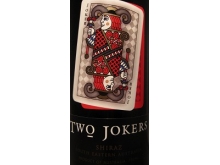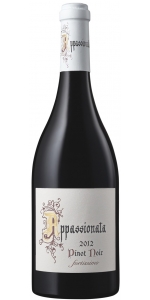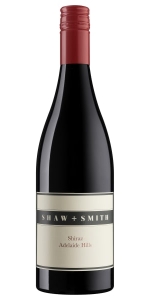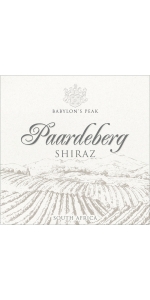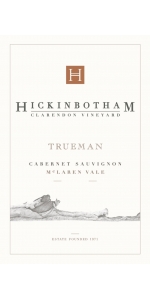Two Jokers Shiraz 2012
| Country: | Australia |
| Region: | South Eastern Australia |
| Winery: | Thorn Clarke |
| Grape Type: | Shiraz |
| Vintage: | 2012 |
| Bottle Size: | 750 ml |
J. Christopher Appassionata Fortissimo Pinot Noir is made from 100 percent Pinot Noir.
Inspired by the three movements of Beethoven’s “Appassionata” Piano Sonata, there are three Appassionata Pinot Noirs, released at different tempos.
The finale of the Appassionata Pinot Sonata is Fortissimo (dynamically forceful). Selected for ultimate expressivity and longevity, it is not released until 10 years after the vintage. This is the epitome of expressive excellence that we are seeking in Willamette Valley Pinot Noir – a wine that combines brooding intensity with lilting grace and can stand alongside the classic wines of the world. The 2012 Fortissimo is muscular and full-bodied, with a deep color and seamless structure. In this phase of maturation, tertiary aromas begin to show a profound complexity and subtle earthiness that only develops with bottle age and cannot be accelerated
Review:
Loosen Bros. and J. Christopher Wines just released the Fortissimo and it is showing great acidity and fine-grained tannins. Its aromas and flavors of sweet red cherries, roasted pork shoulder and orange-pekoe tea are alive and kicking. Enjoy 2023–2032.
-Wine Enthusiast 95 Points
More intense than you might expect from an 11 year old Pinot Noir, certainly one that has been held back at the estate for 10 years before release. Grilled raspberry leaf and reductive smoky notes greet you on the nose here, with sweet black fruits softening the tangy red cherry and cranberry of Oregon Pinot, all wrapped up with waves of leather, sage and tobacco. This has power and succulence, and even at 10 years old it feels pretty young, just at the beginning of its development with a good decade ahead of it. Late release is an unusual approach in Oregon, but not so unusual if you follow Loosen’s winemaking in the Mosel, where he has been known to keep Riesling between 20 and 30 years in barrel. In this case the barrel ageing is for around two years, with the rest taking place in the bottle. Old fashioned winemaking, delicious results. 20% new oak. Fermented with natural yeast, unfiltered and unfined. Tim Malone winemaker. First time on the Place from this wine, from a vineyard in the foothills of the Chehalem Mountains in Oregon’s Willamette Valley. Heavy bottle.
- Jane Anson - Inside Bordeaux 97 Points
James Goddard was an ancestor of the Clarke family. Born in West Sussex, England in 1823, James spent his 74 years as a sailor, a whaler, a bullock driver, farmer, prospector, miner and hotel keeper. From an illiterate runaway living rough on the streets of London, he became a rich, successful and admired pillar of South Australian society.
James arrived in Adelaide in 1839 as a 16-year-old sailor. Twelve years later, his life changed forever with the news of gold findings. For the next 20 years, James roamed the country learning the geology that improved his chances of prospecting.
James Goddard Shiraz is made from 100 percent Shiraz.
In 1870, he tried his luck near his farm in the Barossa Valley and discovered the region’s first gold deposits, creating the prosperous Lady Alice Mine. The Lady Alice Mine, though it is no longer operational, was & still is the most successful gold mine in South Australia. From these roots, the Thorn-Clarke family has been connected to the region for the last 150 years.
James Goddard Shiraz is a blend Shiraz sourced from the Milton Park vineyard in the north of Eden Valley, and the St Kitts vineyard in the far northern area of the Barossa. Fruit is harvested in the cool of the night to maintain maximum flavour and freshness and it is fermented for 8 days. The ferment is pumped over twice daily to extract the colour and flavour from the fruit. Once finished fermentation the wine was then matured in a blend of French and American oak for a period of 10 to 12 months depending on the vintage.
Deep vibrant red with purple hues to the rim. The nose shows lifted plums, vibrant purple berries and a delicate spice note. The palate has concentrated satsuma plum, blackberry with lovely charry oak in the background. Long, juicy and even with plush fruit on the finish.
Review:
“Blended from two estate vineyards, St. Kitts and Milton Park, this shiraz offers its richness without any aggression or overt perfume. It’s just lush and delicious, a friendly embrace of firm tannins and purple-red fruit. The texture and flavor combine in a saturated meatiness, for Korean barbecue.”
- Wine & Spirits Magazine, 92 points
First vinified in 2002, Shaw + Smith Shiraz has quickly garnered attention a standout cool climate Austrlian shiraz.
Sourcing immaculate fruit from the cool Adelaide Hills region, Shaw + Smith carry out whole berry fermentation in open-topped steel vats allowing for gentle yet thorough extraction and optimal aromatics. Maturation in French oak allows tannins to soften and aromas to harmonize before bottling under screw cap.
Shaw + Smith own two vineyards in the Adelaide Hills, at Balhannah and Lenswood, totalling 55 hectares. The vineyards are planted to varieties that perform particularly well in the region, namely Sauvignon Blanc, Chardonnay, Pinot Noir, and Shiraz.
Hand picked, sorted and fermented as a combination of whole berries and whole bunches in open fermenters, with gentle plunging and minimal working. Aged in French oak for fourteen months, of which one third was new.
Shaw + Smith Shiraz is a medium bodied cool-climate Shiraz, in which balance is more important than power.
Decant and enjoy with slow cooked lamb shoulder.
Review:
Lovely crunchy fruit to this, with spice and dried-meat undertones through the wine, from the nose to the palate. Medium body, fine tannins and a fresh and vivid finish. Tangy and bright. Drink or hold. Screw cap.
-James Suckling 94 Points
Babylons Peak Paardeberg Shiraz is made from 100 percent Shiraz.
Babylon's Peak winery, situated on the highest weathered granite slopes of the Paardeberg Mountain, is privately owned by the Basson family who has passed down the tradition, passion and art of winemaking over four generations. Predominantly low-yield dryland bushvines are selected to produce these excellent wines with distinctive character.
A classic Shiraz with dark fruit, violets and white pepper. An elegant wine with ripe tannins and a lingering aftertaste.
The grapes were harvested by hand. The grapes were destalked only, no crushing was done. Cold maceration was done before fermentation started in open fermenters. The grapes fermented between 24-26°C for 5-7 days, after which the wine was taken to barrels where it went through malolactic fermentation. After malolactic fermentation was completed, the wine spent 14 months in 225 litre French oak barrels until bottling.
Pairs with rich and creamy meat dishes eg. oxtail and venison.
Hickinbotham Brooks Road Shiraz is made from 100 percent Shiraz.
After the hand-picked Shiraz clusters were delivered from high country (210-230 meters) by Viticulturer Michael Lane, the winemaker destemmed and sorted the whole berries into open fermenters. The cold soak was four days, the skins plunged three times daily, and the minimum time on skins was eighteen days. The wine was then basket pressed; its free run and pressings kept separate. To minimize filtration at bottling, three rack-and-returns were conducted over fifteen months as the wine seasoned in a mixture of Burgundy-coopered barrels.
This Shiraz shows the characters this vineyard has displayed since the start, but perhaps in a more elegant, harmonious and balanced form. Its consistency is comforting and reassuring, buttressed by blue and black fruit notes throughout. It is readily enjoyable but has all the structure, acid and tannin to offer decades of rewards from cellaring.
Review:
A rich, succulent mix of dark chocolate, spiced plum, wild blackberry and black licorice notes. Showcases both power and elegance, with chai, cigar box, violets and dried sage notes, velvety and generous, on the long, generous finish. Drink now through 2035. 1,900 cases made, 370 cases imported
-Wine Spectator 95 Points
Hickinbotham Trueman Cabernet Sauvignon is made from 100 percent Cabernet Sauvignon.
Trueman represents Cabernet in Clarendon at its best. Its purity, its elegant style, its supple, polished nature ... it’s a wine of its own.Distinct in character, this is not like Cabernet from the Vales below or the hills to the east. From its pretty, delicate florals and musk, through to its silky blackcurrant and kalamata juice and down to its dark carbon soul - Trueman is a modern Cabernet that encapsulates all the toil and antiquity of Clarendon. Echoing the unearthed prose of wine writer Ebenezer Ward from 1886 on theCabernet sown from this very land – Trueman is “an excelled wine, of very marked flavor and bouquet”.
Review:
Deep garnet/purple, the 2012 Cabernet Sauvignon Hickinbotham Vineyard has a classic nose showing pronounced fresh blackcurrant and blackberry highlighted by cloves, menthol, pencil shavings and earth notes. Medium to full-bodied, taut and muscular, the palate has grainy tannins, nice freshness and a long finish.
-Wine Advocate 93 Points
"Aged for 12 months in American oak barrels. Deep red color. The wine is deep and rich smelling with dark fruits plums and spice with some good oak. There is very rich fruit on the palate with plums blackberry and sweet spice from the oak. The palate is vibrant and young with a flavorsome viscous mouthfeel which will develop complexity with time. There are some slightly chewy tannins which will soften with time and there is great length of fruit flavor." Winemaker's Notes
The Thorn Clarke Estate
The winery owners are David and Cheryl Clarke (born Thorn) and their son Sam is the manager of the winery. The Thorn-Clarke family has a long history in the Barossa - six generations of involvement in the region's world famous wine industry. The Thorns have been grape growers in the Barossa since the 1870's. David Clarke's passion for the wine industry lead to the planting of the Kabininge vineyard outside of Tanunda in 1987, which represents the start of a deeper involvement by the family in the Barossa wine industry.
The Thorn Clarke Vineyards
St Kitts and Truro Vineyards--Cooler, and with lower rainfall, these northern Barossa vineyards totaling 103 hectares, are at an elevation of between 380 and 410 meters.
Mt Crawford Vineyard--Late ripening, high rainfall and with elevations as high as 475 meters above sea level, this 37 hectare Eden Valley vineyard can easily be confused with the Adelaide Hills - which is after all just across the range. This site was specially selected as it was considered ideal to grow grape varieties which respond to cold climate.
Kabininge Vineyard--In stark contrast, the 33 hectare Kabininge vineyard is true Barossa Valley floor terroir. At just 270 meters above sea level red winegrapes ripen easily here.
Milton Park Vineyard--Located in classic Eden Valley country, between Angaston and Keyneton, the Milton Park vineyard has an elevation of between 330 and 400 meters above sea level.
- back
Arzuaga Ladera del Norte Ribera del Duero is made from 100% Tempranillo.
The grapes come from organic crops and are harvested from the "Valdesardon" farm, owned by the Arzuaga Navarro family, which is the westernmost vineyard of the Ribera del Duero DO, located at an altitude of 800 meters in the village of Olivares de Duero. Clay-limestone soil on a hillside that will mark the characteristics of the wine.
The wine is of medium high intensity in color, a clear and bright cherry with purple flashes. An array of red fruits such as raspberry and cherry predominates with a high aromatic intensity, combining with balsamic tones, coffee and roasted notes coming from the aging in oak barrels without being overwhelming. This is a fresh and elegant wine, with an easy and balanced entry into the mouth followed by juicy and chewy sensations. Slightly sweet and toasted notes, and a pleasant and balanced aftertaste that is reminiscent of the fruity aromas on the nose.
Ideal companion for red meat, white meat, game and game, roasted or in sauce. Blue fish and soft cheeses.
Review:
"Intense cherry color. Aromas of dried herbs, creamy oak, black fruits and lactic notes. In the mouth, ripe fruits, spices, fine tannins, full-bodied."
- Penin 2022, 92 pts
100% apple wine. A blend of Golden Delicious and Fuji apples hand-picked in the Shenandoah Valley; aromas and flavors of freshly harvested apples, blossoms and spices. (semisweet)

